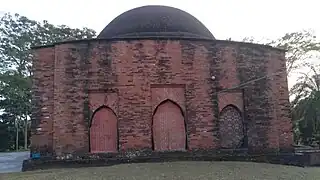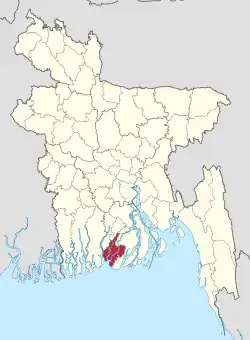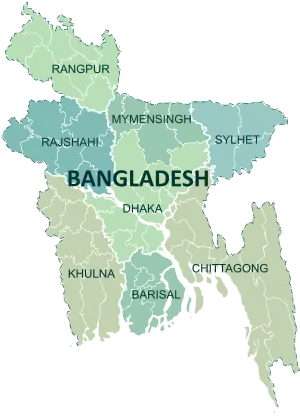Barguna District
Barguna (Bengali: বরগুনা Borguna) is a district in the division of Barisal, Bangladesh.[4] It is situated in the southern part of Bangladesh. Barguna subdivision was established in 1969 and promoted to a district on 28 February 1984.
Barguna
বরগুনা | |
|---|---|
| Barguna District | |
.jpg.webp)   .jpg.webp) .jpg.webp) .jpg.webp) From top: Seabirds in Barguna Coastal area (Laldia beach), Tengragiri Wildlife Sanctuary, Bibicini Shahi Mosque, Haringhata Reserved Forest, Ashar Chor and Bibicini Shahi Mosque | |
 Location in Bangladesh | |
Expandable map of Barguna District | |
| Coordinates: 22.1508°N 90.1264°E | |
| Country | |
| Division | Barisal Division |
| Government | |
| • Deputy Commissioner | Mustain Billah |
| • District Council Chairman | Md. Delwar Hossein [1] |
| • Chief Executive Officer | Md. Owahedur Rahman |
| Area | |
| • Total | 1,831.31 km2 (707.07 sq mi) |
| Population (2022 census)[2] | |
| • Total | 1,010,530 |
| • Density | 550/km2 (1,400/sq mi) |
| Time zone | UTC+06:00 (BST) |
| HDI (2018) | 0.586[3] medium · 16th of 21 |
Etymology
There is not enough strong proof of naming the district. Some historians say that timber traders of the northern region came here to buy timbers and waited for the favoring flow (Baro - Gone) to overcome and from there the name "Baro-Gana" was derived. Others say that it was named after a famous Rakhine resident of this district while some say that the name came from a bawali named "Barguna"[5]
History
Barguna district was in the Sundarban area. In the evolution of time, people started clearing the forest by cutting down the trees and started to live here. Wood merchants used to come here to collect woods from the forest.
Geography
The Barguna District has a total area of 1939.39 km2. It was established as a district on 28 February 1984. It is bounded on the north by the districts of Jhalkathi, Barisal, Pirojpur and Patuakhali. In the east, it borders the Patuakhali district. On the south, Barguna is bounded by the Patuakhali district, and the Bay of Bengal. On the western side, it borders Pirojpur and Bagerhat districts. There are six upazilas, six thanas, four municipalities, 42 unions and 560 villages. Important rivers include the Paira River, Bishkhali River, Khakdon river, Baleshwar River and Haringhata river. The total area of the river is 160 km2 which is 22% of the total area of the district. Moreover, there are 300 natural canals in the district. The average annual temperature is 33.3°C and annual lowest temperature is 12.1°C. Annual rainfall of the district is 2506 mm. Total area of reserved forest area is 30533.90 acres.[6]
Administration
Barguna district has 6 upazilas and 42 unions. Taltali is the newest. The upazilas are:
| Upazila | Area (km2) | No. of Unions | Population (2011) |
|---|---|---|---|
| Amtali | 720.76 | 7 | 244,438 |
| Bamna | 101.05 | 4 | 79,564 |
| Barguna Sadar | 454.39 | 10 | 219,729 |
| Betagi | 167.75 | 7 | 110,926 |
| Patharghata | 387.36 | 7 | 134,635 |
| Taltali | 258.94 | 7 | 88,004 |
Economy
Barguna's economy is primarily dependent on agriculture. Principal crops include rice and pulses. Jute cultivation was once important, but it gradually lost popularity as a cash crop. Being a coastal district, Barguna has a thriving fishing industry. Produce of the district includes betel leaf, pulses, bananas, betel nut, molasses, marine fish, and shrimp. Total area of agricultural land is 104231 hectares.
There is no major industry in this district. A number of small manufacturing industries comprise mostly rice mills, saw mill, soap factory, flour mill, ice factory and pen factory. There are 25 food processing industries, 10 chemical industries, 10 textile home-craft industries and 35 miscellaneous industries in this district. Majority of the industries are in the sadar area and the remainings are in different upazilas. Traditional cottage industries such as weaving, bamboo and cane art work, goldsmithing, blacksmithing, pottery, wood work, and tailoring also thrive in rural areas.[7]
Demographics
| Year | Pop. | ±% p.a. |
|---|---|---|
| 1974 | 589,147 | — |
| 1981 | 677,771 | +2.02% |
| 1991 | 775,693 | +1.36% |
| 2001 | 848,554 | +0.90% |
| 2011 | 892,781 | +0.51% |
| 2022 | 1,010,530 | +1.13% |
| Sources:[2][8] | ||
According to the 2022 Census of Bangladesh, Barguna District had 255,390 households and a population of 1,010,530, 22.8% of whom lived in urban areas. The population density was 552 people per km2. The literacy rate (age 7 and over) was 80.5%, compared to the national average of 74.7%. The ethnic population was 1,131.[2]
Religion
| Religion | Population (1941)[9]: 100–101 | Percentage (1941) | Population (2011)[8] | Percentage (2011) |
|---|---|---|---|---|
| Islam |
292,935 | 85.50% | 822,652 | 92.14% |
| Hinduism |
44,391 | 12.96% | 68,678 | 7.69% |
| Others [lower-alpha 2] | 5,305 | 1.55% | 1,451 | 0.17% |
| Total Population | 342,631 | 100% | 892,781 | 100% |
The overwhelming majority of the population of the district is Muslim, with the population share of Hindus seeing a decline since the 1981 census, when they constituted 9.35 per cent. The same has been true for Buddhists and Christians. Similar to other districts in the Barisal division, the absolute number of all the three minority populations reduced in the 2001-2011 period.
The district has 3,760 mosques, 144 temples, one church and 18 Buddhist pagodas.[4]
Education
Barguna town is a home to many educational institutions. Barguna Zilla School is the oldest school in the town established in 1927 as Barguna Middle English School by Mr. Ramzan Ali Akon.[10] Notable schools and colleges include Barguna Government College, Barguna Government Women's College, Barguna Zilla School, Barguna Govt. Girls High School, Gourichanna Nawab Salimullah Secondary School etc. Besides these, there are two teacher training colleges, a Government Polytechnic institute, a technical school and college and a textile vocational institute in the town. The educational activities are operated under the Board of Intermediate and Secondary Education, Barisal. There are total 1332 educational institutions. There are 2 government and 22 non government colleges, 2 government and 148 non government high schools, 814 government primary schools, 339 madrasas, one non government B.Ed. college, one government primary teachers training institute, one government polytechnic institute, one government technical institute and college and one government textile vocational institute. Notable educational institutions are:
- Barguna Polytechnic Institute
- Patharghata K. M. Secondary School
- Ramna Sher-E-Bangla Samabay High School,
- Govt. Sarwarjan Pilot Model School & College
- Begum Faizunnessa Mohila Degree College
- Halta Dauwatala Wazed Ali Khan Degree College
- Taslima Memorial Academy
- Barguna Govt. College
- Govt. Bamna College
- Barguna Zilla School
- Barguna Govt. Girls school
Health
There is a modern government general hospital in this district which has 100 bed capacity but an upgradation of 250 bed capacity is under construction. Besides this, there are 5 upazila health complexes, 8 upazila health centres and 123 community clinics in this district. There are total 32 government doctors servicing this whole district. There is a lack of total 134 doctors in the hospitals and clinics.[6]
Transportation
There is direct connection from the capital to this district by road. The total length of Upazila Road is 464 km, of which 352 km is concrete and 112 km is dirt. The total length of Union Road is 568 km. 336 km, of which is concrete and 232 km is dirt. Sakura travels, Mia travels, Abdullah travels, Sugandha travels, Patuakhali express, Meghna travels, and Saudia travels are major bus travels.
Total length of riverway is 250 nautical miles. M.V. Bandhan-7, Juboraj-4, Juboraj-2, Allahu Marji, Nusrat, Mashiran Khan, Tipu-3 are some of naval transports available in this district.
There is no airport in this district.[11]
Member of the eleventh Jatiyo Sangsad (2020 - current)
| Area | MP[12] | Party |
|---|---|---|
| Barguna-1 | Dhirendra Debnath Shambhu | Awami League |
| Barguna-2 | Showkat Hasanur Rahman (Rimon) | Awami League |
Notable places
- Bibichini Shahi Mosque, located at Betagi[4]
- Buddhist temple, located at Taltali[4]
- Buddhist Academy[4]
- Horin Ghata Eco Park, located at Patharghata
- Ashar Char
- Bihanga Island
Notable people
- Qamarul Ahsan, politician and litterateur
- Syed Rahmatur Rob Irtiza Ahsan, politician
- Md. Akhtaruzzaman, Vice-Chancellor, University of Dhaka, was born in Kalipur village[13]
- Zafrul Hasan Farhad, former parliamentarian
- Delwar Hossain, politician
- Shahjada Abdul Malek Khan, politician
- Abdul Kader Mia, member of the Bengal Legislative Assembly
- Nurul Islam Moni, politician
- Sultana Nadira, politician
- Siddiqur Rahman, politician
- Mir Sabbir, actor
See also
Notes
- Bamna, Pathargata, Betagi, Barguna and Amtali thanas of Bakerganj district
- Including Jainism, Christianity, Buddhism, Zoroastrianism, Judaism, Ad-Dharmis, or not stated
References
- zp.barguna.gov.bd
- Population and Housing Census 2022: Preliminary Report. Bangladesh Bureau of Statistics. August 2022. pp. 27, 29, 31, 38, 45. ISBN 978-984-35-2977-0.
- "Sub-national HDI - Area Database - Global Data Lab". hdi.globaldatalab.org. Retrieved 2020-03-18.
- Md Monir Hossain Kamal (2012). "Barguna District". In Sirajul Islam and Ahmed A. Jamal (ed.). Banglapedia: National Encyclopedia of Bangladesh (Second ed.). Asiatic Society of Bangladesh.
- "Background of district". Bangladesh national portal. Archived from the original on 2021-03-04. Retrieved 2019-03-10.
- "Barguna at a glance". Bangladesh national portal. Archived from the original on 2021-02-25. Retrieved 2019-11-10.
- "Business and industries". Bangladesh national portal. Archived from the original on 2021-04-16. Retrieved 2019-11-10.
- "Bangladesh Population & Housing Census-2011, Zila Report: Barguna" (PDF). Bangladesh Bureau of Statistics. p. 18.
- "Census of India, 1941 Volume VI Bengal Province" (PDF). Retrieved 13 August 2022.
- "Barguna Zilla School". www.barisalboard.gov.bd. Retrieved 2021-06-11.
- "Transportation system of district". Bangladesh national portal.
- "List of 11th parliament members". Bangladesh Parliament.
- "History of the Institute". Dhaka University.
